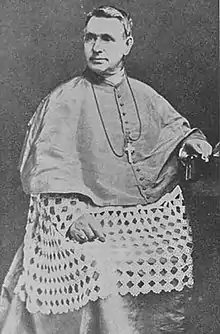Thomas Nulty
The Most Reverend Dr. Thomas Nulty or Thomas McNulty (1818-1898) was born to a farming family in Fennor, Oldcastle, Co. Meath,[1][2] on 7 July 1818, and died in office as the Irish Roman Catholic Bishop of Meath[3] on Christmas Eve, 1898.

Biography
Nulty was educated at Gilson School, Oldcastle, County Meath, St. Finians, Navan Seminary and Maynooth College. He was ordained in 1846. Nulty was a cleric during the Great Famine. During the course of his first pastoral appointment, he officiated at an average 11 funerals of famine victims (most children or the aged) a day, and in 1848 he described a large-scale eviction of 700 tenants in the diocese.[4]
Nulty rose to become the Most Reverend Bishop of Meath and was known as a fierce defender of the tenant rights of Irish tenant farmers throughout the 34 years that he served in that office, from 1864 to 1898.[5][6] Nulty was in agreement with the economic ideas of the progressive reformer Henry George. Nulty read George's book Progress and Poverty multiple times and agreed with every word.[7] Henry George even said that 'Georgism' could just as well be known as 'Nultyism'.[8]
Thomas Nulty is famed for his 1881 tract Back to the Land, wherein he makes the case for land reform of the Irish land tenure system.[9] Nulty was a friend and supporter of the Irish nationalist Charles Stewart Parnell until Parnell's divorce crisis in 1889.[10][11]
Dr. Thomas Nulty, who had attended the First Vatican Council in 1870, said his last mass on 21 December 1898.
| Catholic Church titles | ||
|---|---|---|
| Preceded by John Cantwell |
Bishop of Meath 1866–1898 |
Succeeded by Mathew Gaffney |
References
- The Tablet (31 December 1898). "Obituary. The Most Rev.Dr.Nulty, Bishop of Meath". Retrieved 8 June 2014.
- Navan & District Historical Society. "Nulty, Bishop Thomas". Retrieved 8 June 2014.
- Eubel, Conrad (1913). Hierarchia Catholica Medii et Recentioris Aevi (in Latin). 8. Monasterii Sumptibus et typis librariae Regensbergianae. p. 195, 382. Digitized, University of Toronto.
- The Tablet. "Ireland (From our Correspondent)". Retrieved 8 June 2014.
- D. Bank & A. Esposito, British Biographical Index, London, K.G. Saur, 1990, Vol. 3 J-O (ISBN 0-86291-393-4), p. 1380 (referencing article on corresponding microfiche 824, 206, and which article cites the London Times for 26 December 1898 at page 4 and Brady's 1877 The Episcopal Succession, ii 361, as its sources)
- "Navan Historical Society - Nulty, Bishop Thomas". Navanhistory.ie. Retrieved 26 November 2013.
- Louis F. Post and Fred C. Leubusher, Henry George’s 1886 Campaign: An Account of the George-Hewitt Campaign in the New York Municipal Election of 1886 (New York: John W. Lovell Company, 1887).
- George, Henry (18 June 1887). "Bishop, Archbishop and Guest". The Standard. 1: 1. Retrieved 1 February 2016.
- "'Back to the Land' (1881) by Dr. Thomas Nulty, Bishop of Meath | Lux Occulta". Lxoa.wordpress.com. 29 May 2011. Retrieved 26 November 2013.
- Lawlor, David (2010). "Political priests: the Parnell split in Meath". historyireland.com/. Retrieved 8 June 2014.
- O'Beirne Ranelagh, John (2012). A Short History of Ireland (3 ed.). Cambridge University Press. p. 300. ISBN 978-1139789264. Retrieved 8 June 2014.